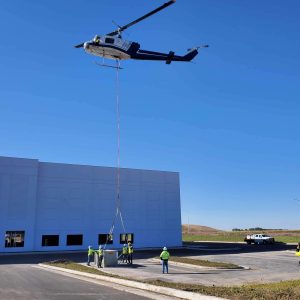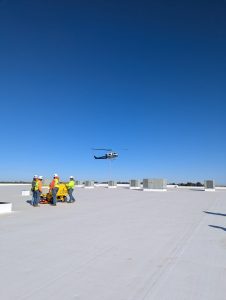The future of healthcare isn’t only about new treatments or cutting-edge equipment, it’s about creating environments that actively support healing, safety, and efficiency. At the heart of that vision? Smart Hospital HVAC systems that do more than heat and cool. They help prevent infection, support patient comfort, and reduce operational costs.
Designing HVAC systems for hospitals and clinics requires more than technical skill. It takes a deep understanding of how people use a space, how air moves through it, and how technology can help us do both better. From advanced filtration and air pressure controls to digital building automation and energy-saving strategies, hospital HVAC is evolving and the right design can make all the difference in how a facility feels, functions, and performs.
It Starts with Outcomes: Safety, Comfort, and Control
In any healthcare setting, the HVAC system must support three key goals: protect patients, support staff, and ensure efficient operations. That means air must be clean and carefully controlled, not just in temperature, but in humidity, filtration, and pressure.
Operating rooms need cool, sterile air with high air change rates and tight humidity control. Patient rooms should be warm and quiet to support healing. Labs, imaging suites, and isolation rooms require specialized pressure differentials to keep pathogens from spreading.
Every space has different demands and the healthcare HVAC system must meet them all, seamlessly.
Regulations and Standards You Can’t Ignore
Healthcare HVAC design isn’t guesswork. Agencies like ASHRAE, the CDC, and the Facility Guidelines Institute (FGI) provide detailed requirements for ventilation, filtration, and air quality in different spaces. For example, ASHRAE Standard 170 outlines specifications for over 80 room types—from emergency departments to meditation rooms.
Key requirements include:
- Air pressure relationships between rooms
- Minimum air changes per hour (ACH)
- Filtration efficiency (often HEPA-level for infection control)
- Temperature and humidity ranges
- Whether air must be recirculated or exhausted
Following these standards ensures compliance and supports better health outcomes. Ignoring them? That can put patients (and your facility’s reputation) at risk.
Designing Hospital HVAC for Efficiency and Performance
Hospitals never sleep, and neither do their HVAC systems. But that doesn’t mean efficiency has to take a back seat. Modern system design includes advanced control strategies, zoning, and energy recovery technologies that reduce energy use while still meeting performance needs.
Variable Refrigerant Flow (VRF) systems, for example, allow refrigerant to flow exactly where and when it’s needed, reducing energy use while giving patients more control over their environment. VRF systems are particularly effective in patient care rooms and administrative areas where individual comfort matters.
Coupled with building automation systems, hospitals can schedule setpoints based on occupancy, optimize airflow in real-time, and reduce energy waste in unused spaces without sacrificing comfort or safety.
Hospital HVAC Technology: Smart Systems and BIM Planning
Today’s healthcare HVAC systems are smarter and more connected than ever. Building automation allows facilities teams to monitor, adjust, and troubleshoot climate conditions across the hospital from a single platform. Occupancy sensors can scale HVAC output up or down based on room usage, and scheduling tools ensure energy isn’t wasted after hours.
But the real magic happens before installation. At Tessiers, we use Building Information Modeling (BIM) to create detailed 3D models of HVAC systems in your facility. This allows us to identify potential conflicts early, coordinate seamlessly with other trades, and ensure precise installations, especially in renovation or retrofit projects where space is tight and uptime is critical.
Infection Control: The Heart of Healthcare HVAC
Clean air saves lives. That’s why infection control is at the core of healthcare HVAC design. High-efficiency particulate air (HEPA) filters capture airborne contaminants before they reach patients or staff. Isolation rooms require negative pressure to keep pathogens in. Operating rooms often use positive pressure to keep contaminants out.
Frequent air changes, humidity control, and proper airflow direction all work together to reduce the risk of hospital-acquired infections (HAIs). But these systems must be maintained. Filters need regular replacement, dampers and sensors must be calibrated, and airflow must be tested consistently.
Designing for 24/7 Reliability and Redundancy
Hospitals can’t afford HVAC downtime. Systems must be designed not only for performance but also for resilience. That includes backup power supplies, equipment redundancy, and built-in service access to minimize disruption during service or repairs.
An experienced mechanical service company will understand how to coordinate system upgrades or replacements without interrupting patient care. From phased shutdowns to after-hours work, proper planning protects both operations and safety.
A Team Approach to Design
Designing the right HVAC system for a healthcare facility isn’t a solo job. It requires collaboration with hospital administrators, clinical staff, architects, engineers, and facility managers. It starts by asking: What are your priorities? Infection control? Energy savings? Patient experience?
From there, we identify the right solutions for each zone, calculate system loads, and analyze life cycle costs. We help balance performance with efficiency, and regulatory compliance with long-term value.
Better Hospital HVAC Design = Better Care
Your HVAC system may never be the star of the show, but when it’s designed well and regularly serviced, it plays a starring role in patient care, staff satisfaction, and cost control.
At Tessiers, we bring over a century of experience, cutting-edge technology, and deep healthcare expertise to every project. (Don’t take our word for it, check out our past healthcare projects.) Whether you’re building new, upgrading an existing system, or looking for proactive maintenance support, we’re here to help you design with purpose and build with precision.

